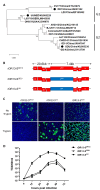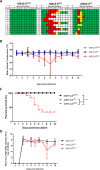Spike gene variability in porcine epidemic diarrhea virus as a determinant for virulence
- PMID: 40001283
- PMCID: PMC11915861
- DOI: 10.1128/jvi.02165-24
Spike gene variability in porcine epidemic diarrhea virus as a determinant for virulence
Abstract
Porcine epidemic diarrhea virus (PEDV) is a pathogenic coronavirus that targets the swine intestinal tract, leading to acute diarrhea and high mortality in neonatal piglets. PEDV is categorized into different genotypes based on genetic variations, especially in the spike (S) gene. The S protein is crucial for viral entry and a major immune target. Significant differences in virulence have been observed among PEDV genotypes, particularly between classical strains and newly emerging strains. In this study, we explored the impact of spike gene variability on PEDV pathogenicity. Using targeted RNA recombination, we generated recombinant PEDV (rPEDV) variants carrying spike genes from contemporary strains (moderately virulent strain UU and highly virulent strain GDU), all within the genetic background of the avirulent DR13 vaccine strain. Pathogenicity was assessed in 3-day-old piglets. The rPEDV carrying the DR13 spike gene was nonpathogenic, with no detectable viral RNA in feces. The rPEDV with the UU spike gene induced mild to severe diarrhea, with moderate viral shedding but no mortality. Conversely, the rPEDV with the GDU spike gene caused severe diarrhea, high viral titers, and high mortality. These findings highlight the critical role of the spike protein in PEDV virulence, informing future development of effective control strategies, including the design of live-attenuated vaccines.IMPORTANCEThis study significantly advances our understanding of how genetic variations in the spike (S) protein of porcine epidemic diarrhea virus (PEDV) influence its ability to cause disease. By engineering viruses with spike genes from different PEDV strains, variations in this protein could be directly linked to differences in disease severity. We found that the spike protein from highly virulent strains caused severe diarrhea and high mortality in piglets, while that from less virulent strains led to milder symptoms. These findings emphasize the central role of the spike protein in determining PEDV virulence, which may enable the design of more effective vaccines to combat PEDV and reduce its impact on the swine industry.
Keywords: PEDV; coronavirus; spike; virulence.
Conflict of interest statement
E.V.D.B., P.J.M.R., and B.-J.B. are listed as inventors of the patents filed on PEDV vaccine strategies. B.N.H., P.V.D.E., and E.V.D.B. are employees of MSD AH. The remaining authors declare no competing interests.
Figures



References
-
- Chen Q, Gauger PC, Stafne MR, Thomas JT, Madson DM, Huang H, Zheng Y, Li G, Zhang J. 2016. Pathogenesis comparison between the United States porcine epidemic diarrhoea virus prototype and S-INDEL-variant strains in conventional neonatal piglets. J Gen Virol 97:1107–1121. doi:10.1099/jgv.0.000419 - DOI - PubMed
MeSH terms
Substances
Grants and funding
LinkOut - more resources
Full Text Sources

